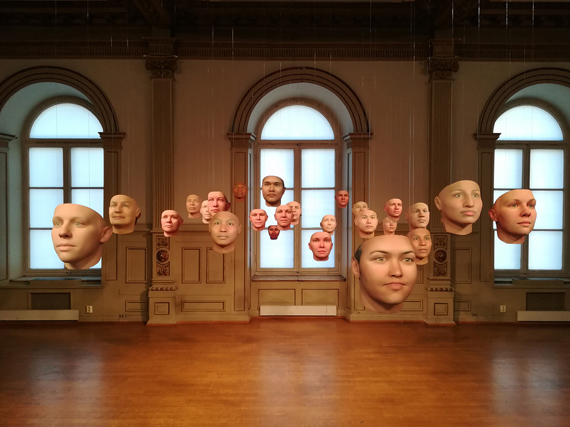
Probably Chelsea, A Becoming Resemblance
2017, Thirty possible Chelsea’s generated algorithmically from her DNA. 3d Prints
Dimensions variable
Courtesy Fridmann Gallery New York
Heather Dewey-Hagborg »
Probably Chelsea, A Becoming Resemblance
2017, Thirty possible Chelsea’s generated algorithmically from her DNA. 3d Prints Dimensions variable
Exhibition: 17 Aug – 30 Sep 2018
Kunsthal 3,14
Vaagsallmenningen 12
5014 Bergen
+47-55-362630
post@stiftelsen314.com
www.kunsthall314.art
Tues-Fri 11-17 . sat, Sun 12-16
Kunsthall 3.14 starts the Autumn season by encouraging and challenging the audience to think about genetic engineering opportunities and ethical constraints. Here we will readily reflect on our technological future and we are in a landscape of social, philosophical and environmental issues. As we, as an art institution, see, the projects of our invited artists help to strengthen our understanding of what and where a development in biotechnology and genetic engineering leads us as an individual and society. Bioart also holds the ability to fill everyone with overwhelming curiosity and trigger our imagination to a great extent. We are excited to present, Probably Chelsea, A becoming Resemblance by Heather Dewey-Hagborg & Chelsea E. Manning, and 2.6g 329m/s – Bulletproof Skin by Jalila Essaïdi. We hope after a visit to the two charged bioart projects, that the viewer inspires critical responses to emerging trends in the life sciences.
The work Probably Chelsea, A Becoming Resemblance by artist Heather Dewey-Hagborg came about as the result of a collaboration with the American whistle-blower Chelsea E. Manning. Manning was imprisoned from 2010 to 2017 for transmitting 40 000 classified documents about the war in Iraq to WikiLeaks. During this time, Manning also underwent Hormone Replacement Therapy in order to transition from her male identity to her female one. No images of her reached the public during the period of imprisonment. In 2015 Manning sent Dewey-Hagborg a buccal swab and strains of her hair from military prison. The artist analyzed the DNA and used algorithmic DNA phenotyping to realize thirty different face models, thirty different digital sketches of Manning's physiognomy, which were then 3D-printed and are now on view in the exhibition.
Probably Chelsea demonstrates the spectrum of visualization possibilities afforded by DNA analysis and how open the translation of data is. The calculation of the portraits leaves a lot of leeway such that the results are imprecise and allow for a broad spectrum of interpretations. Nonetheless, the results are accepted as factual, and specialized firms offer the phenotyping process used here on a commercial level. On the basis of minimal DNA components, they produce facial composites that are used in criminal investigations as well as forensic archaeology.
The molecular reality, however, is far more complex. Sex and race can't be determined purely on the basis of DNA traces. Probably Chelsea thematizes precisely this lack of conclusiveness in the reading process and the resultant spectrum of possibilities. The thirty faces demonstrate a broad spectrum of bodily traits. The genome offers probabilities concerning an individual’s outer appearance, but not a clear and distinct representation of them. Each of the thirty faces is equally as right as it is wrong. On a molecular level, we could all be Chelsea E. Manning.
The American artist Heather Dewey-Hagborg (b. 1982) is a transdisciplinary artist and educator who is interested in art as research and critical practice. Her work was presented internationally at exhibitions and events, such as the World Economic Forum, Zurich (CH), the Shenzhen Urbanism and Architecture Biennale (CN), at the New Museum, New York (US), the Centre Pompidou, Paris (FR) and PS1 MOMA, New York (US).
Chelsea Elizabeth Manning (b. 1987), known as Bradley Edward Manning before retrospectively changing her birth certificate was a member of the US Armed Forces and an IT specialist.
The exhibition is in collaboration with Fridman Gallery, New York, and Kunsthall 3.14 is part of a larger tour of the work to among other institutions such as Frankfurter Kunstverein, and as part of Transmediale at Haus der Kulturen der Welt, Germany; MU Art Space in Eindhoven, The Netherlands; Perth Institute of Contemporary Arts (PICA), Australia.�